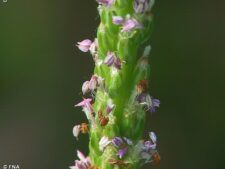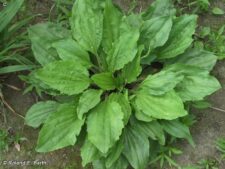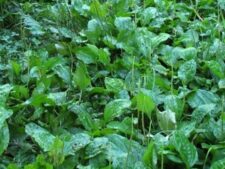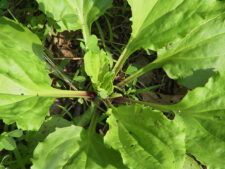
RUGEL’S PLANTAIN
Plantago rugelii
PLANTAIN FAMILY (Plantaginaceae)
 Identification
Identification
- Flowering time - June, July, August, September
- Common on trails, roadsides, compacted ground
- Rosette of large oval leaves
- Reddish or purplish stem bases
- Slender, dense flower spikes rising from the center of the rosette
This native perennial grows up to 15 inches tall. Large oval leaf blades, up to 8 inches long, are arranged in a rosette (C). Leaf stalks are usually reddish-purple at their base near the ground (F). The tiny flowers are pale green and white or lavender (B); they are arranged on one or more tall spikes emerging from the center of the leaf rosette (A,E). As the plant matures, the compact flowers are replaced by overlapping elongated capsules containing many tiny black seeds.
On and along trails, roadsides and other compacted ground. Common on most woodland trails in Fontenelle Forest and Neale Woods where it sometimes forms a carpet covering the entire trail as shown in image (D). Flowering occurs from June to September.
The reddish or purplish lower stems and narrower, more elliptical seeds separate our native Rugel’s Plantain from its similar introduced Eurasian cousin Common Plantain (Plantago major) which has green stem bases and more oval seed capsules. Both are common lawn and garden “weeds”.
The edible leaves and stems are an important food source for small mammals and a variety of insects. It is the a host plant for the larvae of several moth species and the Buckeye butterfly.
Other common names include American Plantain and Blackseed Plantain.
The content of NatureSearch is provided by dedicated volunteer Naturalists of Fontenelle Forest who strive to provide the most accurate information available. Contributors of the images retain their copyrights. The point of contact for this page is: Roland Barth.





